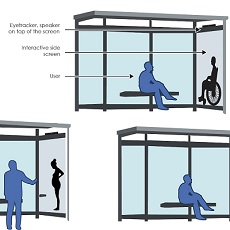Introduction to the idea
Consideration for others is a constant struggle between our selfish base instincts and our need to rise above these behaviours in order to function effectively as a society. We all go through this inner struggle, to fight against our need to benefits ourselves as individuals at the expense of others. One everyday selfish act that many people are not aware of is not giving up your seats on a bus to people in need, such as elders, pregnant or disabled people. Reflected Reality challenges bus commuters to think about their own imprint on societal resources, and how their use of these resources can infringe on the needs of others, especially those who may need these resources more than themselves. Social provocation is utilized as a vehicle to confront individual selfishness in the face of other members of society that need resources more than ourselves.
Interacting with Reflected Reality
So how does our installation work? We’ve designed our interactive exhibit to work in the digital advertising panels that are integrated into bus-stops. Our design challenges bus commuters to think about their own imprint on societal resources, and how their use of these resources can infringe on the needs of others, especially those who may need these resources more than themselves.
A poster pertaining to human selfishness will initially be disguised as a static bus stop advertisement. When users sit down at the bus stop, a makey-makey pressure pad activates, initiating a live action representation of a less fortunate commuter appearing on the screen adjacent to the bus-stop seat.
Utilizing eye tracking technology, Reflected Reality will detect If the user does not pay attention to the live action character, and reveal a negative consequence for their unwillingness to show altruism for others. The less fortunate commuter representation may experience negative consequence. The negative or positive result will then show-up as part of a static bus stop poster, and remain until the exhibit is activated by the next user.
Design inspiration and Iteration
With this focus on human selfishness established, we searched for inspirations to help express our theme. We were inspired by successful advertising campaigns that persuasively employed interactive elements to challenge and shift viewpoints and behaviours.
A paraplegic foundation successfully created an advertisment like this. It used optical illusion to give the impression that a bus-stop commuter was wheelchair bound. The action of the user getting up to catch a bus is then used to illustrate the desire of the foundation to see paraplegics walk again. Like this design, We wanted our idea to create the same thought provoking effect on potential users, challenging their perceptions and promoting reflective thought.
Three iterations of the concept have been made. The concept was originally more of an interactiove animation. After feedback from user testing it was noted that the animation style was not powerful enough for the message at hand. Due to this and the research conducted the idea was changed to a more life like simulation.





